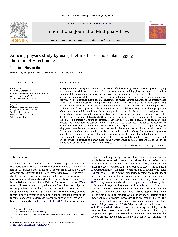摘要
An experimental investigation was conducted to quantify the unsteady heat transfer and phase changing process within small icing water droplets in order to elucidate underlying physics to improve our understanding of the important micro-physical process of icing phenomena. A novel, lifetime-based molecular tagging thermometry (MU) technique was developed and implemented to achieve temporally-and-spatially resolved temperature distribution measurements to reveal the time evolution of the unsteady heat transfer and dynamic phase changing process within micro-sized water droplets in the course of icing process. It was found that, after a water droplet impinged onto a frozen cold surface, the liquid water at the bottom of the droplet would be frozen and turned to solid ice rapidly, while the upper portion of the droplet was still in liquid state. As the time goes by, the interface between the liquid phase water and solid phase ice was found to move upward continuously with more and more liquid water within the droplet turned to solid ice. Interestingly, the averaged temperature of the remaining liquid water within the small icing droplet was found to increase, rather than decrease, continuously in the course of icing process. The temperature increase of the remaining liquid water is believed to be due to the heat release of the latent heat during solidification process. The volume expansion of the water droplet during the icing process was found to be mainly upward to cause droplet height growth rather than radial to enlarge the contact area of the droplet on the test plate. As a result, the spherical-cap-shaped water droplet was found to turn to a prolate-spheroid-shaped ice crystal with cusp-like top at the end of the icing process. The required freezing time for the water droplets to turn to ice crystals completely was found to depend on the surface temperature of the test plate strongly, which would decrease exponentially as the surface temperature of the frozen cold test plate decreases.
- 出版日期2010-8
